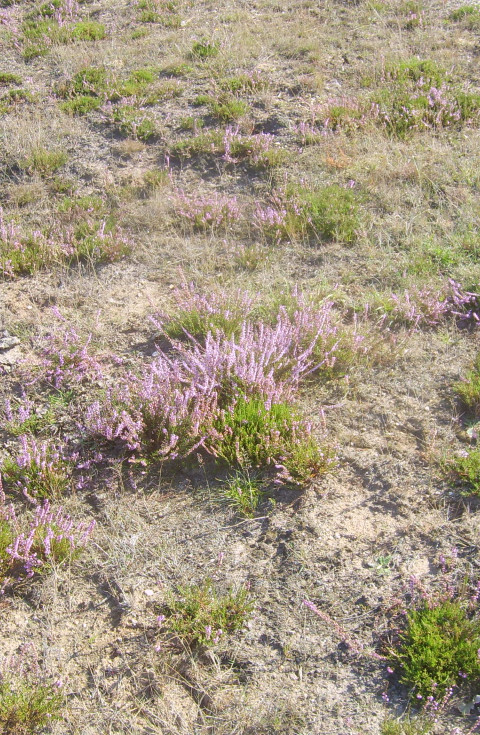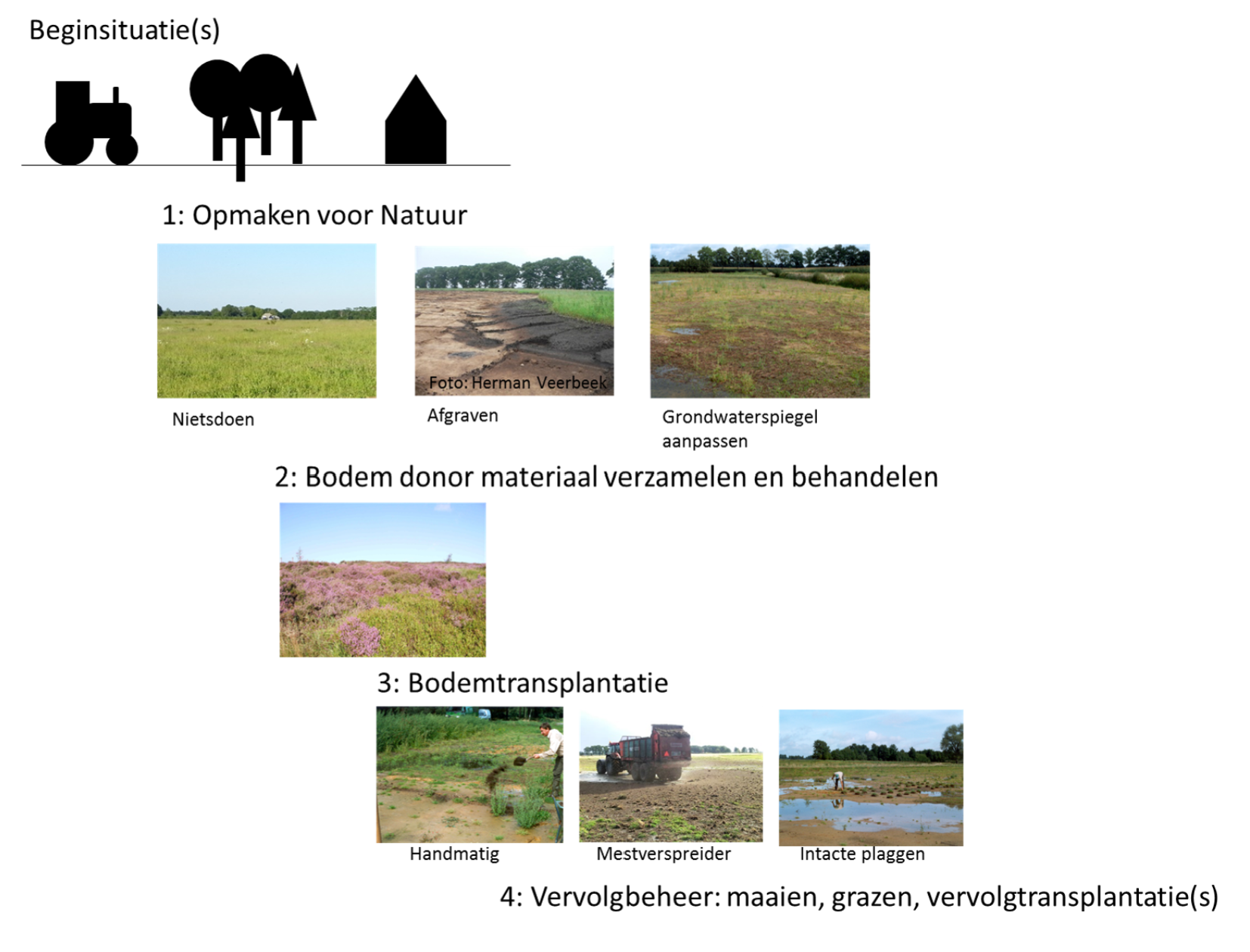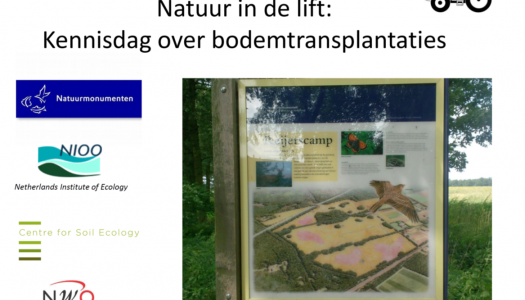Soiltransplantation

How can former arable fields be restored to nature? How can we turn a heavily managed soil into a species-rich grassland or heathland? And what is the role of soil organisms in steering plant communities? This website and film explain soil transplantations for nature restoration and development.
What is soil transplantation?
Transporting soil from a donor area and spreading this soil over another area is what we call soil transplantation. Soil from a donor area is distributed (transplanted) thinly over the surface of a different area. Soil transplantation is often used to speed up nature development on former arable lands, using soil from nature reserves to kick-start nature in the new location.
Why is soil transplantation implemented?
In the Netherlands, new nature reserves are frequently established on former arable fields. Spontaneous nature development is often slow. The target (plant) species don’t establish immediately, because their seeds aren’t present, and because (a)biotic conditions aren’t optimal yet.
Nature managers steer new nature development in different ways. Unwanted plants and seeds are removed by mowing, grazing or excavating. Excavating can also help to reduce the high amounts of nutrients in soil from fertilizers. The groundwater table can be altered to encourage either wetland or dry ecosystems.
The composition of the soil (micro)organisms has been largely neglected in nature development. We know that plants and soil organisms interact and depend on each other. Soil life can thus have a large impact on plants colonising a new area. By transplanting soil from a nature reserve into a newly to be developed area, both the target soil organisms and plant seeds are brought to the new area. This ensures that the target vegetation can develop quicker.
Above: after soil transplantation, target soil organisms and plants establish and interact, eventually forming
the desired ecosystem.
Below: If no target soil organisms and plants are brought in, pioneer plants and soil organisms will establish, and
interact, but the target vegetation will not be promoted. Without soil transplantation it is highly unlikely that the
desired ecosystem will establish.
How are soil transplantations applied?
Soil material is excavated from the donor location, and spread in a thin layer over the new area. Different techniques of soil spreading have been tried, such as: soil crumbling, slurry (mixing soil with water), or digging in of intact soil sods. More informational about these methods can be found under “Step-by-step”.
Where can we find examples of soil transplantations?
In the Netherlands, several soil transplantation experiments have been carried out to convert former arable fields to nature reserves. A recent example can be found at Reijerscamp, Gelderland. Under the tab “Map” locations and details of more soil transplantation projects in the Netherlands can be found.
Why this website about soil transplantations?
The Netherlands Institute of Ecology – Royal Netherlands Academy of Arts & Sciences (NIOO-KNAW) in collaboration with the Dutch Society for Nature Preservation (Natuurmonumenten) organised an information day about soil organisms, nature development and soil transplantations on 15 October 2015. This day was attended by many stakeholders and nature restoration practitioners. During the meeting results of the Reijerscamp soil transplantation experiment were presented, as well as the principles of soil transplantation, its use for nature restoration, the practical application of soil transplantations, and ethical questions around soil transplantations. Clearly many practitioners still had questions about how and when soil transplantations can best be used for nature development. To answer those questions NIOO-KNAW created this website, with support of the Netherlands Organisation for Scientific Research (NWO).
Research on soil transplantations at NIOO-KNAW
We study different aspects of soil transplantation, soil organisms, soil fertility, biodiversity and nature restoration. For instance, we found that on former arable fields, sowing of target plant seeds is more effective than removing topsoil for grassland restoration (Kardol et al. 2008), and that soil transplantations decrease the time to establish heathland on former arable fields (Wubs et al. 2016). Martijn Bezemer, Wim van der Putten, and Jasper Wubs are currently working on fundamental and applied soil transplantation research.
Step by step
How to perform a soil transplantation
Common starting points:
- Former arable fields on sandy soil
- Forest on sandy soil
- Built/urban area
1) Preparing for nature
Research
Biotic and abiotic properties of the donor soil should resemble the restoration area as much as possible. To achieve a good match, we need to investigate whether we should perform preparations in the restoration area, and where the donor material can be sourced.
Doing nothing
Soil transplantations don’t necessarily need large-scale preparation. Doing nothing can suffice to start a soil transplantation. The donor material can then be spread onto the restoration area directly.
Topsoil removal
To the ploughing depth of arable fields, the topsoil contains a high amount of nutrients. This hinders the development of (species-rich) grasslands or heathlands. Also, the topsoil doesn’t contain seeds of plant species that we want there, and contains the wrong soil organisms to promote nature restoration.
A first step can be to excavate to the maximum ploughing depth, onto the parent material. This removes the fertilised, nutrient-rich topsoil layer that contains few of the target plant seeds and soil organisms. A new start is made for the development of more natural biotopes.
The depth of topsoil removal varies and depends on the depth of ploughing during previous agricultural practise. Abiotic soil properties need to be taken into account. By excavating too deep, the hydrological environment can change, the organic matter content may become too low to support soil organisms, or soil chemical properties may inhibit colonisation of the specified plants.
Adapt the groundwater table
Sometimes it is necessary to alter the groundwater table, especially for the development of wet, nutrient-poor grasslands that rely on a high groundwater table (e.g. Molinia meadows).
Conserve/apply relief
It may be desirable to preserve cultural-historic landscape remnants such as old dykes, mounds or watercourses. Additions or re-enforcements of local relief create a varied and diverse landscape.
2) Collection and treatment of soil transplantation donor material from nature reserve
Soil material is collected from a nature reserve to spread over the area that will be developed. It is important that as little damage as possible be caused to the existing nature reserve, and that the collection work is done in moderation. Depending on the way the transplantation is performed, intact soil sods can be excavated, or bulk soil material. Intact sods also contain the target plants and their roots.
Intact sods don’t need to be treated and can be transplanted directly.
For the collection of bulk soil material, the top 5-10 cm of the donor site is excavated from 0.5 m2 squares. As long bulk soil is collected from several small patches, the damage is limited. This material is crumbed as much as possible with the help of a spade.
Bulk soil materials from the donor location are easiest to spread onto the new area after homogenisation by crumbing or by mixing with water, creating a slurry.
3) Application of nature reserve soil onto the newly developed area
In smaller areas and when sufficient manpower is available (volunteers), soil from the donor location can be spread manually onto the new area using spades and rakes. Intact soil sods can be manually dug in.
In larger areas, soil from the donor location is spread using a manure spreader onto the newly developed area. This results in spreading approximately 1 liter of soil material per square meter, leading to a thin layer of transplanted soil of on average 1 mm.
4) Continuation
Monitoring of the soil transplantation is needed to observe if and how fast the targeted plant species are establishing, and whether adjustments are needed.
Usually soil transplantations show success within the first years, with the desired plants (grasses, heather) coming up. Sometimes additional measures are needed. This could be another soil transplantation or seeding, in case the targeted plant species don’t start growing. In heathlands it is common practise to manage grass encroachment through mowing, grazing, and eventually excavation if grasses have taken over the heathland.
Locations
Heathland:
Bartokpark Arnhem; Dommeldal; Galderse Heide; Golfclub de Koepel; Heiderijk Nijmegen Mook; Kerckebosch; Kuinderbos; Landgoed de Lage Lier; Loonse en Drunense Duinen; Nieuwe Renkumse Heide; Reijerscamp
Species-rich grassland:
Banisveld; Mantingerveld; Noordenveld, Dwingelderveld; Oudemirdum; Staverden; Wekerom; Wisselse Veen; Wolfsven
Wet, nutrient-poor Grassland (Molinia meadow):
Moerputten - Blues in the Marshes
Dry siliceous grassland Nardetea:
Forest:
Publications
Literature in English:
- Aradóttir, Á.L., 2012. Turf transplants for restoration of alpine vegetation: does size matter? Journal of Applied Ecology 49, 439–446.
- Aradóttir, Á.L., Óskarsdóttir, G., 2013. The use of native turf transplants for roadside revegetation in a subarctic area. Icelandic Agricultural Sciences 26 , 59-67.
- Balser, T.C., Firestone, M.K., 2005. Linking microbial community composition and soil processes in a California annual grassland and mixed-conifer forest. Biogeochemistry 73, 395–415.
- Bezemer, T.M., van der Putten, W.H., Martens, H., van de Voorde, T.F.J., Mulder, P.P.J., Kostenko, O., 2013. Above- and below-ground herbivory effects on below-ground plant–fungus interactions and plant–soil feedback responses. Journal of Ecology 101, 325–333.
- Brown, S.C., Bedford, B.L., 1997. Restoration of wetland vegetation with transplanted wetland soil: an experimental study. Wetlands 17, 424–437.
- Bullock, J.M., 1998. Community translocation in Britain: Setting objectives and measuring consequences. Biological Conservation 84, 199–214.
- Carbajo, V., den Braber, B., van der Putten, W.H., de Deyn, G.B., 2011. Enhancement of late successional plants on ex-arable land by soil inoculations. PloS one 6, e21943.
- Harris, J., 2009. Soil Microbial Communities and Restoration Ecology: Facilitators or Followers? Science 325, 573–574.
- Jaunatre, R., Buisson, E., Dutoit, T., 2014. Topsoil removal improves various restoration treatments of a Mediterranean steppe (La Crau, southeast France). Applied vegetation science 17, 236–245.
- Kardol, P., Bezemer, T.M., van der Putten, W.H., 2009. Soil organism and plant introductions in restoration of species‐rich grassland communities. Restoration Ecology 17, 258–269.
- Kiehl, K., Kirmer, A., Donath, T.W., Rasran, L., Hölzel, N., 2010. Species introduction in restoration projects – Evaluation of different techniques for the establishment of semi-natural grasslands in Central and Northwestern Europe. Basic and Applied Ecology 11, 285–299.
- Klimeš, L., Jongepierová, I., Doležal, J., Klimešová, J., 2010. Restoration of a species‐rich meadow on arable land by transferring meadow blocks. Applied Vegetation Science 13, 403–411.
- Marrs, R.H., 2016. Ecological restoration: Soil microbes call the shots. Nature Plants 2, 16117.
- Meola, M., Lazzaro, A., Zeyer, J., 2014. Diversity, resistance and resilience of the bacterial communities at two alpine glacier forefields after a reciprocal soil transplantation. Environ Microbiol 16, 1918–1934.
- Middleton, E.L., Bever, J.D., 2012. Inoculation with a native soil community advances succession in a grassland restoration. Restoration Ecology 20, 218–226.
- Mudrák, O., Fajmon, K., Jongepierová, I., Doležal, J., 2016. Restoring species‐rich meadow by means of turf transplantation: long‐term colonization of ex‐arable land. Applied Vegetation Science doi: 10.1111/avsc.12281.
- Nishihiro, J., Nishihiro, M.A., Washitani, I., 2006. Restoration of wetland vegetation using soil seed banks: lessons from a project in Lake Kasumigaura, Japan. Landscape and Ecological Engineering 2, 171–176.
- Pywell, R., Webb, N., Putwain, P., 1995. A comparison of techniques for restoring heathland on abandoned farmland. Journal of Applied Ecology 32, 400–411.
- Rokich, D.P., Dixon, K.W., Sivasithamparam, K., Meney, K.A., 2000. Topsoil handling and storage effects on woodland restoration in Western Australia. Restoration Ecology 8, 196–208.
- Santala, K.R., Monet, S., McCaffrey, T., Campbell, D., Beckett, P., Ryser, P., 2015. Using turf transplants to reintroduce native forest understory plants into smelter‐disturbed forests. Restoration Ecology 24,346-353.
- Sohlenius, B., Boström, S., 1999. Effects of climate change on soil factors and metazoan microfauna (nematodes, tardigrades and rotifers) in a Swedish tundra soil–a soil transplantation experiment. Applied Soil Ecology 12, 113–128.
- Sun, B., Wang, F., Jiang, Y., Li, Y., Dong, Z., Li, Z., Zhang, X.-X., 2014. A long-term field experiment of soil transplantation demonstrating the role of contemporary geographic separation in shaping soil microbial community structure. Ecology and Evolution 4, 1073–1087.
- Vécrin, M., Muller, S., 2003. Top‐soil translocation as a technique in the re‐creation of species‐rich meadows. Applied Vegetation Science 6, 271–278.
- Wubs, E., van der Putten, W., Bosch, M., Bezemer, T.B., 2016. Soil inoculation steers restoration of terrestrial ecosystems. Nature Plants 2, 16107.
- Wubs, J., Bezemer, T.M., 2014. Soil transplantations for nature restoration on former arable fields-next steps. Nieuwsbrief Onderzoeksprogramma Biodiversiteit Werkt 2014, 39–40.
- Zumsteg, A., Bernasconi, S.M., Zeyer, J., Frey, B., 2011. Microbial community and activity shifts after soil transplantation in a glacier forefield. Applied Geochemistry 26, S326–S329.
Literature in Dutch
- de Vries, M.W., Bobbink, R., Jansen, A., Vogels, J., 2016. Herstel kwaliteit van natte heide in het zandlandschap. Landschap: tijdschrift voor Landschapsecologie en Milieukunde 33, 110–115.
- Kardol, P., Van der Wal, A., Bezemer, T.M., De Boer, W., Van der Putten, W., 2009. Ontgronden en bodembeestjes: geen gelukkige combinatie. De Levende Natuur 110, 57.
- Loeb, R., van der Bij, A., Bobbink, R., Frouz, J., Diggelen, R., 2011. Ontwikkeling van droge heischrale graslanden op voormalige landbouwgronden. OBN Rapport nr. 2013/OBN176-DZ.
- Natuurmonumenten, 2013. Natuurherstel De Loonse en Drunense Duinen Layman’s Report.
- Noordwijk, C., Weijters, M., Smits, N., Bobbink, R., Kuiters, A., Verbaarschot, E., Versluijs, R., Kuper, J., Floor-Zwart, W., Huiskes, H., 2013. Uitbreiding en herstel van Zuid-Limburgse hellingschraallanden. Eindrapportage 2e fase O+ BN onderzoek. Bosschap.
- van Duinen, G.-J., Bouwman, J., van Kleef, H., de Vries, M.W., 2014. Randvoorwaarden voor het herstel van kenmerkende en bedreigde soorten in het natte zandlandschap. OBN Rapport nr. 2014/OBN187-NZ.
- van Noppen, F., Bosch, M., Wubs, E., Haanstra, L., Verbaan, W., van Houwelingen, D., Philippona, J., van Ekeris, R., Van der Putten, W., Bezemer, T., 2015. Afgraven, bodemtransplantaties en uitstrooien van maaisel op voormalige landbouwgronden: het Reijerscamp experiment. De Levende Natuur 116, 222–226.
- Wubs, E., van der Putten, W., Bosch, M., Bezemer, T.M., 2016. Natuurherstel door grondtransplantatie. Landschap 33, 11-14.
Contact
Koen Verhoeven
k.verhoeven@nioo.knaw.nl
+31 (0)317 473 400
Droevendaalsesteeg 10
6708 PB Wageningen
Postbus 50
6700 AB Wageningen



